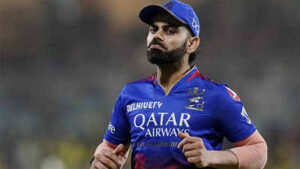
Midway into Royal Challengers Bengaluru’s innings against Sunrisers Hyderabad on Thursday, Star Sports commentators interviewed Muttiah Muralitharan, Sunrisers’ assistant coach, and asked him if he was bowling at the nets. “I’m too old now,” said the off-spin maestro. “Also, the way cricket has changed over the last two years, against these batters (I don’t have a chance).”
By then, the ‘troll army’ was out in force on social media, and Virat Kohli was trending. After making a rapid start against Sunrisers, the RCB opener got stuck and got out for a 43-ball 51. His strike-rate was 118.60 and a two-paced pitch didn’t justify the slowdown, given that Rajat Patidar, at the other end, scored a 19-ball half-century. Kohli scored 22 runs from the first 12 balls he faced. His next 29 runs came off 31 deliveries. He scored at seven runs per over when the rest of the team scored at 12.
Social media, at its worst, can be a cesspit of toxic behaviour, hate and disinformation, and some of the criticism against Kohli deplorably reeked of pure hate. Support in the personality-based fan following of Indian cricket can be polarised and the majority of the hatemongers, who revelled in running down one of India’s greatest-ever cricketers, probably haven’t ever even played tennis-ball cricket.
But amid the viral hate addiction, there were a few who talked logic. A netizen called Kohli’s innings “outdated” and expressed his disappointment over “one of the greatest T20 batsmen not adapting” to the new demands of the T20 format.
Upping the ante, especially against spin, in the middle overs has been Kohli’s problem. His strike-rate against spin in last year’s IPL was 110. And this has thrown open the debate about his utility at the upcoming T20 World Cup. Kohli will go to the ICC event, but will his batting style, opening the innings or at No. 3, help the Indian team?
Only a few days ago, Sunrisers scored 125 for no loss in the Powerplay against Delhi Capitals. Totals of 200-plus are being posted for fun. At a time when the batsmen are ready to live by the sword and die by it without the fear of failure, Kohli’s approach of anchoring the innings and playing at his own pace has indeed become outdated. He is the Orange Cap holder in this IPL with 430 runs from nine games. But his strike-rate is 145.76.
There’s, however, a counter-logic. T20Is don’t have an Impact Player Rule a la the IPL. Also, pitches in New York and especially in the West Indies, where the T20 World Cup would be played, are unlikely to be absolute belters. Teams might need players who thrive on quality batsmanship rather than brutal power-hitting.
Pitches in this year’s IPL have been heavily lopsided in favour of the batsmen and as former England captain Mike Atherton wrote in his The Times (London) column, it has put the game on a “slippery slope”. At the same time, as Atherton mentioned, the IPL “influences the rest of cricket” and Kohli will have to adapt.
RCB’s return-leg fixture against Sunrisers was a case in point, where the victory margin was 35 runs and Patidar’s half-century was a game-breaking effort. Even two years ago, 140 was considered to be a fair strike-rate in T20 cricket. Now, anything less than 150 is not acceptable. The 65-run partnership between Kohli and Patidar told a story, where the former RCB skipper scored a run-a-ball 14 and Patidar hammered 50 off 20 deliveries. Kohli had four fours and a six in his innings, while Patidar smoked five sixes.
Top international teams like England and Australia have moved on from their bonafide legends in international T20 cricket. England no longer pick Joe Root and Australia have discarded Steve Smith. Unless there’s an eleventh-hour change of heart from the selectors (and the team management), Kohli will go to the T20 World Cup. But his batting approach may well determine India’s chances in the tournament.